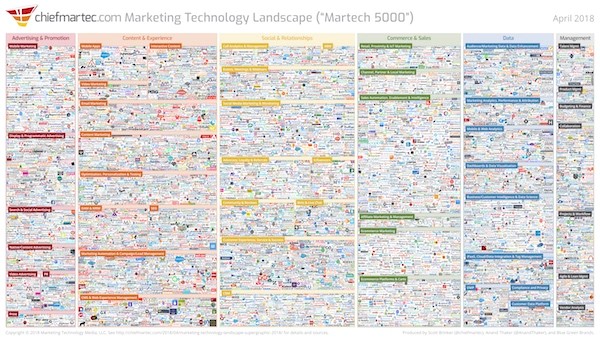Cultivating fantastic content through people, process, and technology
08 November 2019
According to Gartner, only 40 percent of marketers are pleased with the quality of their content. That’s a poor reflection of the amount of dollars, energy, blood, sweat and tears invested in content creation by corporate marketers.
Yet marketing leaders claim that one of the biggest barriers to creating effective content marketing is a lack of time and resources to improve its performance. Especially in enterprise businesses, the vision of an integrated, end-to-end content experience for customers requires a lot of coordination. It takes a combination of people, process, and technology.
We’ve rounded up the top considerations when architecting your content teams, determining how they should work, and choosing the technology stack to support your content and marketing efforts.
People: Champion content savviness
It is critical to ensure that the right roles are in place, and that employees have the right training to deliver effective content. At Metia, we have a Global Content Network (GCN) to help our clients scale effortlessly and deliver authentic, resonant content across industries and geographies, in all formats and deliverables. When we designed the GCN there were a few roles that we knew would make a big difference, and they each should have a particular mindset:
- A data-smart Content Strategist
The content strategist covers some critical bases: translating data, insights, and goals into an actionable content plan; advocating for the customer in all content projects; and keeping an eye out for the conversations that competitors are trying to have with customers. The individual in this role must use data as an enabler to create authentic content that focuses on achieving the desired outcomes. - Conversation-oriented Content Creators
Start thinking beyond people who are strictly designers or writers and look for people who can see how words and visual communication hang together. As Colleen Jones, the CEO of Content Science, points out, “The layout, visual cues, microcopy, contextual help, and flow together add up to the experience, and the people creating the experience need to think holistically about it, together.” - Data Analysts with a mind for psychology
Knowing how to operationalize customer behavior so it can be tracked with data is key to enabling testing and learning from content. For example, in developing a measurement framework for a client who was publishing thought leadership content, a Metia data specialist devised a metric that could indicate influence, based on how much of the web content a user actually The learning is that: stepping back and asking what behavior you’re trying to capture through data, can result in tracking more meaningful metrics than page views or likes. - Silo-breaking Project and Content Managers
Whether this person is overseeing a specific channel, product line, region, or department, if the team is involved in the production of content, the managerial role needs to look left and right and see where their peers in the organization are coalescing around the same story. Those who hope to be team players both on the immediate team and in the organization at large, are natural fits for the cultural changes involved in digital transformation.
Process: Injecting strategy and integrating execution
A strategically-led content operation connects the dots between strategy and execution. It ensures that content creators are thoroughly briefed on the strategy and understand the desired outcome of what they are producing, as well as guidance on the tactics to use for achieving it. The content operation documents the workflows and best practices to reduce churn and confusion. It also enforces the measurement of outcomes, gaining the ability to test and learn from content.
The result? Delivering better content instead of just more content, and finding organizational efficiencies at the same time. According to Kapost, organizations that implement a strategic content operation see a 30 percent increase in productivity without increasing costs.
Likewise, efforts in today’s content production process should involve breaking down silos and integrating content operations. The organizing principle for content production becomes the end-to-end customer journey as opposed to traditional departments or channels. When integrating, think about how the thread of conversation with a customer flows through the organization, and make sure that hand-off points have adequate context and briefing around them. And to sustain the integration over time, institute a content governance framework that serves as a north star across groups to ensure everyone is heading in the same direction and it’s clear what roles can make decisions about content.
Integration also drives success both inside and outside the organization. McKinsey regularly observes ‘up to 15 percent revenue increases and simultaneous reductions in cost to serve of more than 20 percent’ for clients that implement an integrated operating model.
Technology: Solving challenges and curating content
After fully understanding the people and processes involved in creating a strategic, integrated content operation, what remains is to look at the technology systems to support them. Many content and marketing teams still rely on legacy systems to produce, publish, and measure content, and these tools often hold them back from achieving the kind of content experience that their customers want. Consider these all-too-common examples:
- Tracking content requests in email as opposed to an editorial calendar or task management tool
- Reporting on content performance in Excel as opposed to a dashboard
- Deploying emails ad hoc as opposed to from a marketing automation tool
- Developing custom-designed websites with no content management system
What’s more, there are a plethora of content marketing tools that will tell you how to solve your content experience challenges. Chiefmartec publishes a dizzying visualization of all the options each year, with over 5,000 tools available in 2018 and growing at an impressive rate.

These tools probably can help solve those challenges!
The key is in due diligence to make sure the new technology adopted will address the requirements of your content strategy and content operation. Establishing a technology core based on those big-picture needs will help you focus on the investments that will drive value and minimize distractions.
If your content strategy does not involve curating content from various sources, don’t worry about adding a content curation tool—there are very cool and effective ones out there, but they won’t help you achieve your goals.
On the other hand, if you produce content regularly across various channels with a team involved in the process, you should standardize on a holistic content production platform across all departments. Or if you know account-based marketing is part of your plan, your website should have a content management system that does personalization well.
Conclusion: Make it real
As with any improvement plan, the march toward creating better content and content operations should happen deliberately and thoughtfully. Metia often helps out our clients with these efforts, starting with crawl/walk/run frameworks, pilots, and POCs all the way through to robust content engines.
In implementing any strategy, we make sure that changes are well communicated and adopted, and that we see positive results as we transition and augment content support.
If you’re looking to improve your content and want to know how Metia’s Global Content Network could help, we’d love to talk with you. Get in touch—we enjoy discussing business challenges, content efforts, and identifying the right content engine configuration for the content you produce.




